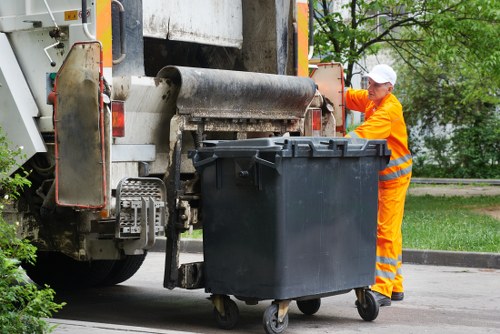Comprehensive Guide to Site Clearance in Victoria
Understanding Site Clearance

Site clearance is a fundamental step in the development and construction process. Whether you are preparing a residential property for building, undertaking commercial construction, or managing land for agricultural purposes, effective site clearance ensures that the land is free from obstacles and ready for development.
In Victoria, site clearance involves the removal of unwanted vegetation, debris, and existing structures in compliance with local regulations. This process not only prepares the land for new projects but also contributes to environmental sustainability by managing waste and preserving natural habitats.
Choosing the right site clearance service is crucial. It involves assessing the specific needs of your project, understanding the regulatory requirements, and ensuring that the clearance is conducted safely and efficiently.
Legal and Environmental Considerations

Victoria has stringent laws governing land use and site clearance to protect the environment and ensure sustainable development. Before initiating any site clearance project, it's essential to obtain the necessary permits and approvals from local authorities.
Environmental impact assessments may be required to evaluate the potential effects of clearance on local ecosystems. This includes managing native vegetation, protecting wildlife habitats, and ensuring that soil and water resources are not adversely affected.
Adhering to these regulations not only ensures compliance but also promotes responsible land management practices. Working with licensed and experienced site clearance professionals can help navigate these legal and environmental requirements effectively.
Types of Site Clearance Services

Site clearance services in Victoria encompass a wide range of tasks tailored to the specific needs of each project. These services can be broadly categorized into:
- Vegetation Removal: Clearing unwanted plants, trees, and shrubs to prepare the land for construction or other uses.
- Debris Removal: Eliminating construction debris, old structures, and other materials that may hinder development.
- Erosion Control: Implementing measures to prevent soil erosion and protect the integrity of the site.
- Land Grading: Shaping the land to ensure proper drainage and create a stable foundation for construction.
Each of these services plays a vital role in ensuring that the site is adequately prepared, safe, and ready for the next phase of development.
Process of Site Clearance

The site clearance process typically involves several key steps:
- Assessment: Evaluating the site to determine the extent of clearance required, including the types of vegetation and structures present.
- Planning: Developing a clearance plan that outlines the methods and sequence of tasks to be performed.
- Execution: Implementing the clearance plan using appropriate machinery and techniques to ensure efficiency and safety.
- Post-Clearance: Conducting site inspections to verify that the clearance meets the project's requirements and complies with regulations.
Each step is critical to the success of the site clearance project, ensuring that the land is properly prepared for its intended use.
Choosing the Right Site Clearance Contractor

Selecting a reputable site clearance contractor is essential for the success of your project. Factors to consider include:
- Experience: Look for contractors with a proven track record in site clearance, particularly in Victoria.
- Licensing and Certification: Ensure that the contractor holds the necessary licenses and certifications to operate legally.
- Equipment: The contractor should have access to the latest machinery and technology to perform clearance efficiently.
- Environmental Practices: Choose contractors who prioritize sustainable practices and adhere to environmental regulations.
By carefully evaluating potential contractors based on these criteria, you can ensure that your site clearance project is handled professionally and effectively.
Costs and Budgeting for Site Clearance
Understanding the costs associated with site clearance in Victoria is crucial for budgeting and project planning. Several factors influence the overall cost, including:
- Size of the Site: Larger sites typically require more resources and time, impacting the overall cost.
- Type of Clearance: The complexity of the clearance, such as removing large structures or dense vegetation, can increase costs.
- Regulatory Compliance: Obtaining necessary permits and adhering to environmental regulations may add to expenses.
- Waste Disposal: Proper disposal of cleared materials must be factored into the budget.
It's advisable to obtain detailed quotes from multiple contractors and consider all potential costs to ensure that your site clearance project remains within budget.
Timeline for Site Clearance Projects
The duration of a site clearance project in Victoria depends on several variables, including the size of the site, the extent of clearance required, and weather conditions.
A typical site clearance project can range from a few days to several weeks. Effective project management and coordination with the contractor can help streamline the process and minimize delays.
Planning ahead and allowing sufficient time for each phase of the clearance will ensure that the project progresses smoothly and meets your development timeline.
Safety Measures in Site Clearance
Safety is paramount in site clearance operations. Contractors must implement comprehensive safety protocols to protect workers, the public, and the environment.
- Personal Protective Equipment (PPE): Ensuring that all personnel are equipped with the necessary PPE.
- Machinery Safety: Regular maintenance and inspection of equipment to prevent accidents.
- Training: Providing adequate training for workers on safe operation procedures and emergency response.
- Site Security: Securing the site to prevent unauthorized access and potential hazards.
Adhering to these safety measures not only complies with legal requirements but also fosters a safe working environment.
Environmental Sustainability in Site Clearance
Promoting environmental sustainability is increasingly important in site clearance projects. Sustainable practices include:
- Recycling and Reuse: Salvaging materials for reuse or recycling to minimize waste.
- Habitat Preservation: Protecting existing wildlife habitats and minimizing disruption to local ecosystems.
- Erosion Control: Implementing measures to prevent soil erosion and protect water quality.
- Carbon Footprint Reduction: Utilizing energy-efficient machinery and reducing emissions.
Integrating these practices ensures that site clearance contributes to the long-term health and sustainability of the environment.
Technological Advancements in Site Clearance
The advancement of technology has revolutionized site clearance in Victoria, enhancing efficiency and effectiveness.
Modern machinery equipped with GPS and automation capabilities allows for precise and swift clearance operations. Additionally, software tools assist in project planning, management, and monitoring, ensuring that projects stay on track and within budget.
Embracing these technological advancements can lead to improved outcomes and a more streamlined clearance process.
Benefits of Professional Site Clearance
Hiring professional site clearance services offers numerous benefits, including:
- Expertise: Professionals bring extensive knowledge and experience to handle diverse clearance challenges.
- Efficiency: Skilled contractors can complete clearance tasks promptly and effectively.
- Compliance: Ensuring that all clearance activities adhere to local laws and environmental regulations.
- Risk Mitigation: Reducing the likelihood of accidents and environmental harm through proper practices.
These advantages make professional site clearance a worthwhile investment for any development project.
Case Studies and Success Stories
Examining successful site clearance projects in Victoria provides valuable insights into best practices and effective strategies.
For instance, a recent residential development project benefited from a comprehensive site clearance plan that included advanced machinery and sustainable waste management, resulting in a smooth transition from a dense forest to a thriving community.
Another commercial project successfully managed erosion control and habitat preservation, setting a benchmark for environmentally responsible clearance practices.
Future Trends in Site Clearance
The future of site clearance in Victoria is likely to be shaped by increasing emphasis on sustainability, technological innovation, and regulatory changes.
Emerging trends include the use of drones for site assessments, the adoption of eco-friendly machinery, and stricter environmental standards that require more responsible clearance practices.
Staying informed about these trends will help property owners and developers adapt and maintain effective site clearance strategies.
Conclusion
Site clearance is a critical component of any land development project in Victoria. It involves meticulous planning, adherence to regulations, and the implementation of sustainable practices to ensure successful outcomes.
By understanding the various aspects of site clearance, including legal requirements, service types, costs, and safety measures, you can make informed decisions that facilitate smooth project progression.
For professional and reliable site clearance services in Victoria, contact us today to discuss your project needs and schedule a consultation.